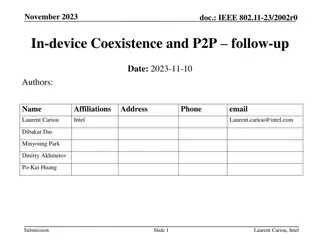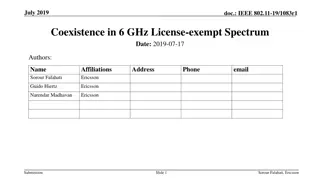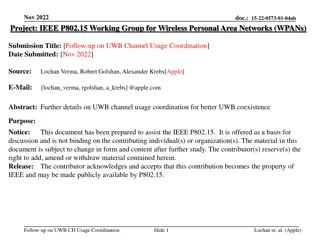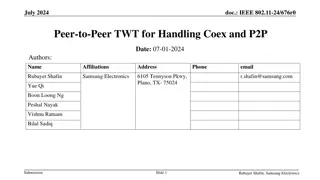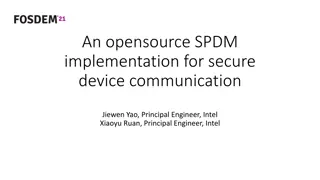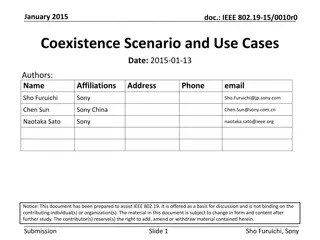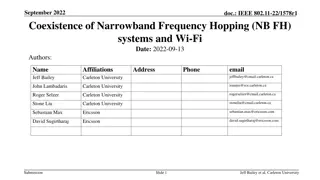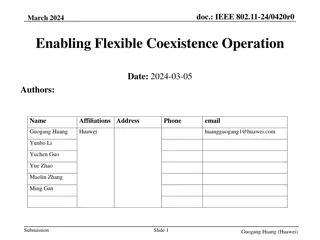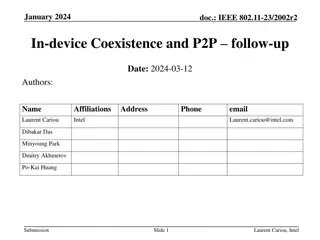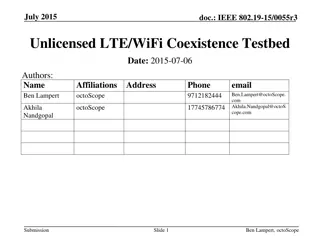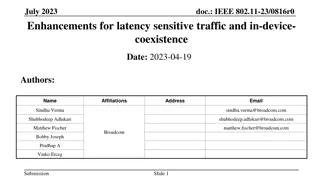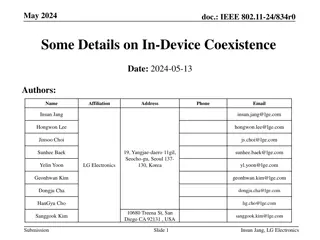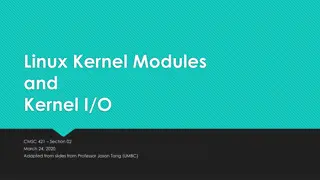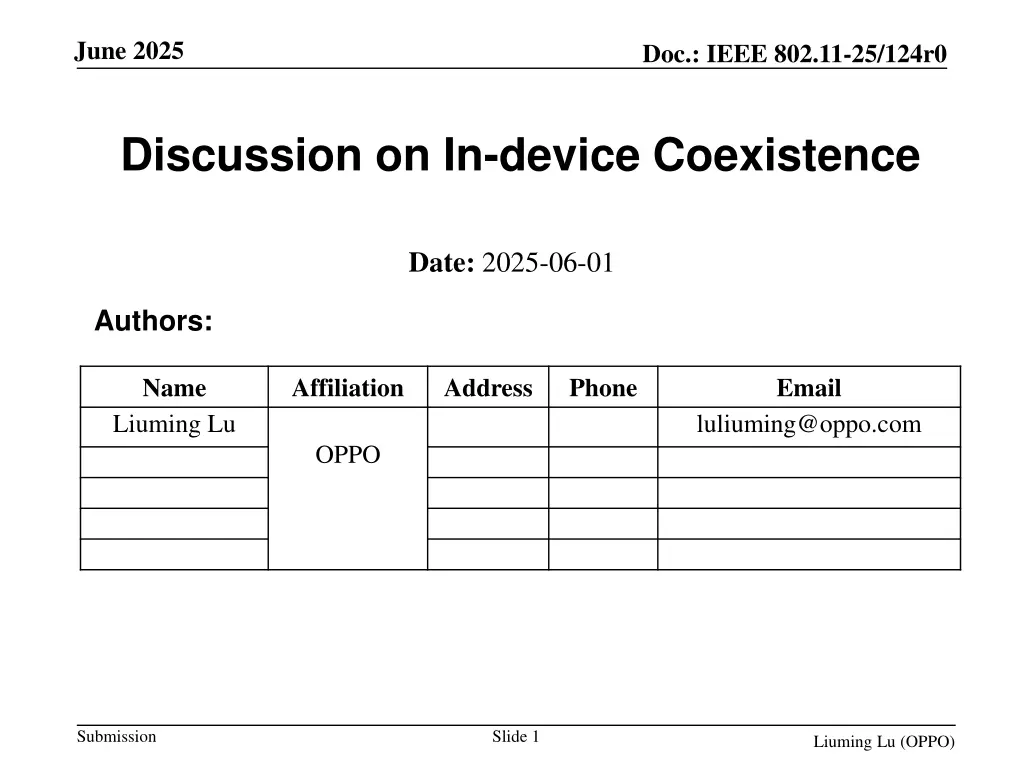
Understanding Unsolicited Unavailability Indications in IEEE 802.11-25/124r0
Explore the analysis and proposals concerning unsolicited unavailability indications in the IEEE 802.11 standard for dynamic unavailability operation. Key considerations include conditions for transmitting such indications and potential impact on network performance.
Download Presentation

Please find below an Image/Link to download the presentation.
The content on the website is provided AS IS for your information and personal use only. It may not be sold, licensed, or shared on other websites without obtaining consent from the author. If you encounter any issues during the download, it is possible that the publisher has removed the file from their server.
You are allowed to download the files provided on this website for personal or commercial use, subject to the condition that they are used lawfully. All files are the property of their respective owners.
The content on the website is provided AS IS for your information and personal use only. It may not be sold, licensed, or shared on other websites without obtaining consent from the author.
E N D
Presentation Transcript
June 2025 Doc.: IEEE 802.11-25/124r0 Discussion on In-device Coexistence Date: 2025-06-01 Authors: Name Liuming Lu Affiliation Address Phone Email luliuming@oppo.com OPPO Submission Slide 1 Liuming Lu (OPPO)
June 2025 Doc.: IEEE 802.11-25/124r0 Introduction A non-AP STA in Dynamic Unavailability Operation (DUO) mode can indicate unavailability in certain Control frames, where the unavailability might overlap with the ongoing TXOP. Two types of unavailability indications are considered: Solicited unavailability indications A non-AP STA in the DUO mode that receives a BSRP Trigger frame from its associated DUO Supporting AP indicates unavailability in a response Multi-STA BlockAck frame Unsolicited unavailability indications A DUO non-AP STA that is operating in the DUO mode and that is a TXOP holder may indicate unavailability in a BSRP Trigger frame This contribution analyzes the issues for unsolicited unavailability indications and gives some proposals for the conditions for the unsolicited unavailability indications to be further considered. Submission Slide 2 Liuming Lu (OPPO)
June 2025 Doc.: IEEE 802.11-25/124r0 Issues for unsolicited unavailability indications The following motion has passed, but the detailed conditions for the unsolicited unavailability indications need further consideration. The following conditions for transmitting unsolicited unavailability indications that can be sent by a non- AP as a TXOP holder in a BSRP GI3 trigger frame: No restriction when sent with QoS data transmitted in the TXOP When sent without QoS data transmitted in the TXOP, not more than MaxStandaloneDuoBSRP number of times every beacon interval where MaxStandaloneDuoBSRP is a non-zero value and part of the DUO parameter set indicated by the AP Note: BSRP GI3 Trigger frame is a BSRP Trigger frame that solicits an M-BA response that is carried in non-HT (dup) PPDU format The excessive unsolicited unavailability indications would increase communication overhead and decrease the network performance. Unnecessary unsolicited unavailability indications especially carried in BSRP GI3 trigger frames should be disallowed. Submission Slide 3 Liuming Lu (OPPO)
June 2025 Doc.: IEEE 802.11-25/124r0 Proposals for unsolicited unavailability indications The following conditions for transmitting unsolicited unavailability indications that can be sent by a non-AP as a TXOP holder in a BSRP GI3 trigger frame: AP can enable or disable the non-AP STA to transmit unsolicited unavailability indications in a BSRP GI3 trigger frame during a time period if allowed. The non-AP STA in DUO mode can transmit unsolicited unavailability indications in a BSRP GI3 trigger frame if it has received the indications that AP has buffered data for the non-AP STA. Submission Slide 4 Liuming Lu (OPPO)
June 2025 Doc.: IEEE 802.11-25/124r0 Summary This contribution analyzes the issues for the unsolicited unavailability indications and proposes that the following conditions for transmitting unsolicited unavailability indications need to be considered : AP can enable or disable the non-AP STA to transmit unsolicited unavailability indications in a BSRP GI3 trigger frame during a time period if allowed. The non-AP STA in DUO mode can transmit unsolicited unavailability indications in a BSRP GI3 trigger frame if it has received the indications that AP has buffered data for the non-AP STA. Submission Slide 5 Liuming Lu (OPPO)
June 2025 Doc.: IEEE 802.11-25/124r0 References [1] IEEE P802.11bn/D0.3 [2] tgbn-motions-list-part-2, https://mentor.ieee.org/802.11/dcn/25/11-25-0014-24-00bn-tgbn-motions- list-part-2.pptx [3] tgbn-motions-list-part-1, https://mentor.ieee.org/802.11/dcn/24/11-24-0171-26-00bn-tgbn-motions- list-part-1.pptx [4] Improving acknowledgment mechanisms, https://mentor.ieee.org/802.11/dcn/24/11-24-0414-01- 00bn-improving-acknowledgment-mechanisms.pptx Submission Slide 6 Liuming Lu (OPPO)
June 2025 Doc.: IEEE 802.11-25/124r0 SP1 SP 1: Do you agree that the following conditions for transmitting unsolicited unavailability indications in a BSRP GI3 trigger frame for the non-AP STA in DUO mode need to be considered : AP can enable or disable the non-AP STA in DUO mode to transmit unsolicited unavailability indications in a BSRP GI3 trigger frame during a time period if allowed. The non-AP STA in DUO mode can transmit unsolicited unavailability indications in a BSRP GI3 trigger frame if it has received the indications that AP has buffered data for the non-AP STA. Submission Slide 7 Liuming Lu (OPPO)


